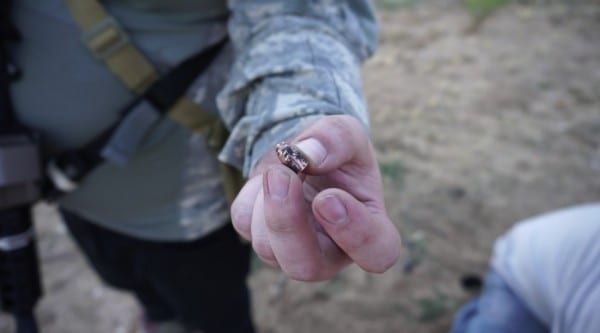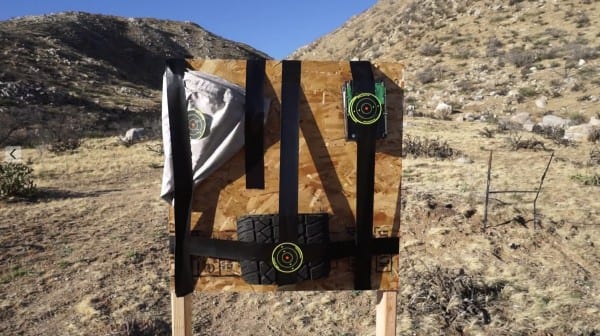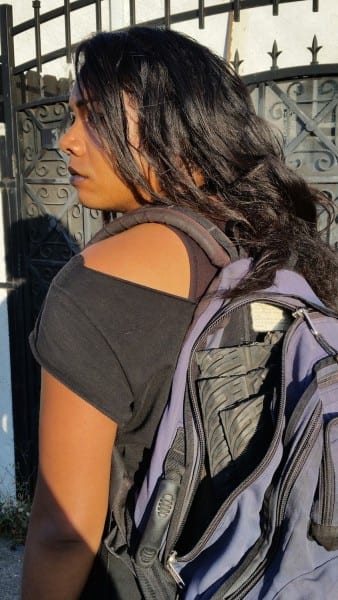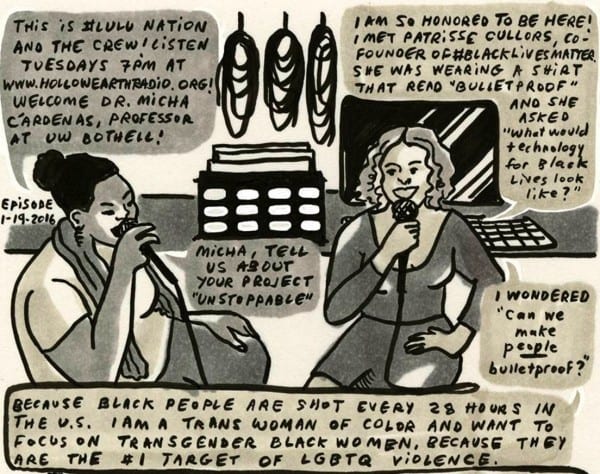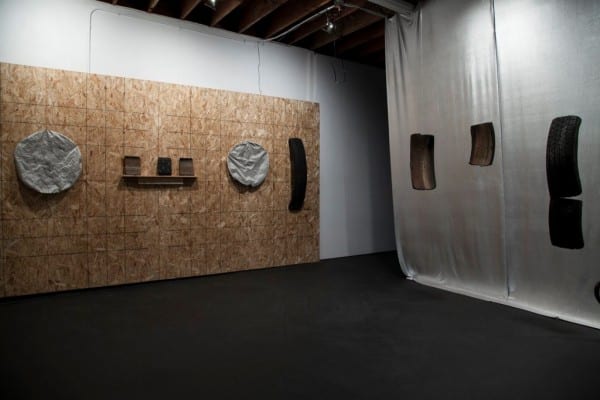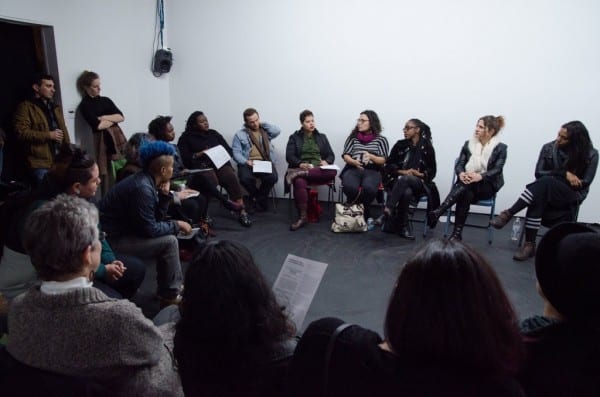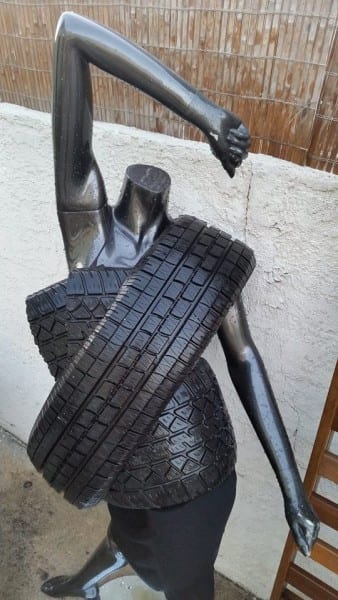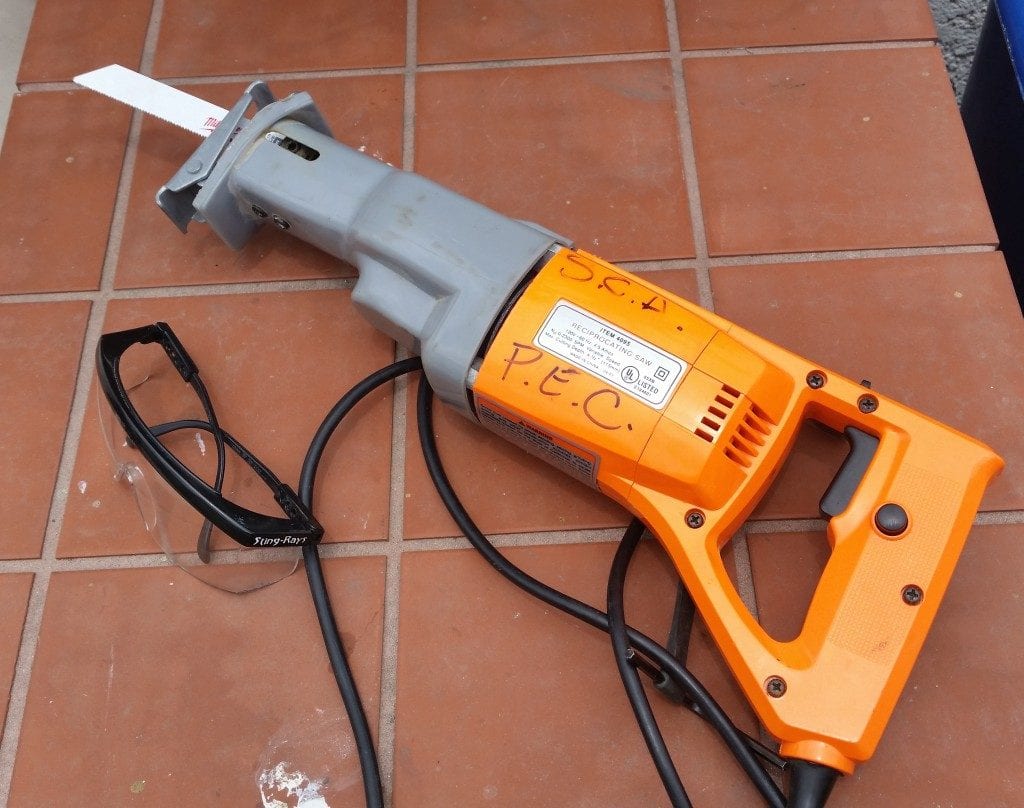Contents
- 1 Unstoppable
- 1.1 Materials Testing #1 and New Designs with Edxie Betts
- 1.2 A comic about the Unstoppable project
- 1.3 Unstoppable exhibition in INCA
- 1.4 First Prototypes: Bulletproof Dress and Backpack
- 1.5 Material Experiment #2: Kevlar Air Bags
- 1.6 Material Experiment #1: Car Tires
- 1.7 Future Materials to Test and Related Projects
- 1.8 About UNSTOPPABLE
UNSTOPPABLE – DIY Bullet Proof Clothing inspired by #BlackLivesMatter

Unstoppable
At the 2015 Allied Media Conference opening ceremony, Patrisse Cullors asked “what would technology for black lives be,” while wearing a shirt designed by Foremost and Damon Turner with the words BULLETPROOF #BlackLivesMatter emblazoned across her chest in gold. Inspired by this idea, micha cárdenas, Patrisse Cullors, Edxie Betts and Chris Head are collaborating to develop UNSTOPPABLE, a set of materials and processes for producing DIY bulletproof clothing at low to no cost. UNSTOPPABLE is art as intervention. The artists have developed a set of instructions for making these garments for wide dissemination. These clothes and prototypes will be the basis for a series of workshops, round tables and conversations about direct action approaches to ending the murder of black people, in particular black trans women, at universities and community centers around the US, and wherever there is interest in hosting these conversations.
The project name comes from the words of Sylvia Rivera, a trans latina leader of the movement for liberation for transgender people, who said “a lot of heads were bashed [at Stonewall]. But it didn’t hurt their true feelings — they all came back for more and more. Nothing — that’s when you could tell that nothing could stop us at that time or any time in the future.” The name also refers to the idea that firearms’ capacity to cause harm is called stopping power. We are unstoppable.
Governments today kill both through direct acts of state violence, such as police killing black people, and through neglect, choosing not to prosecute the murders of trans women, or looking the other way when civilians and paramilitaries arm themselves and commit murder. In this state of necropolitics, where the government facilitates death for communities it deems unwanted, we must act to physically protect ourselves now, as we do not even know where the next bullet might come from.
UNSTOPPABLE
micha cárdenas, Patrisse Cullors, Edxie Betts and Chris Head
18 December – 22 January
Curated by Aejandra Salinas and Aeron Bergman
—————————————–
INCA SEATTLE (NEW SPACE)
2 West Roy St. Seattle, WA, 98110
Uptown (Lower Queen Anne)
Exhibition: 18 December – 22 January
Opening: 18 December 7:30-9:30pm
Opening hours: Wednesday-Saturday 3-7pm
Closed: 24,25,31 December and Jan 1st
—————————————–
Conversation: micha cárdenas, Edxie Betts, Kiyomi Fujikawa, C. Davida Ingram and Nikkita Oliver on 18 December at 8:30pm
Organized by micha cárdenas
—————————————–
Public conversation: December 18, at 8:30pm there will be a public conversation about how art can be a space to develop direct action strategies to save the lives of black trans women, trans women of color and black people more broadly. Artist/theorist micha cárdenas has invited a range of conversants including artists and activists Edxie Betts, Kiyomi Fujikawa, C. Davida Ingram and Nikkita Oliver to get the conversation started. The conversation will include everyone who shows up to the event and will center on these questions:
– What direct action strategies can we imagine to stop the murders of black trans women, black people and trans women of color?
– How have you used art to create change to save black lives?
– How can artists and organizers work together to create change, now, without asking other people to do it for us?
– Relative to our art and expressions, for those of us whom are either black or trans or both, what are ways we can heal ourselves and uplift each other from some of the deepest internalizations of white supremacy, anti-blackness, and trans misogyny without perpetuating ‘master narratives’ and symbology that say we will always be oppressed?
Bios:
C. Davida Ingram
Seattle-based artist C. Davida Ingram received the 2014 Stranger Genius Award in Visual Arts. She is a writer and artist-curator who focuses on creating counter-narratives via education, performance, and curating. She is co-founder of the Seattle People of Color Salon, and has been involved with many community-based arts organizations including Video Machete, Women in the Director’s Chair, and Insight Arts. Her recent projects included Avatar: Fanon & Decca; Object Lesson: Where Can My Black Ass Go to Be Safe; I Wish a Motherf***** Would. Her work continually explores the intersections of social justice, social practice, and the art of protest.
———-
Kiyomi Fujikawa
Kiyomi Fujikawa is a Seattle-based, gender-fabulous, queer, mixed-race organizer. Kiyomi has been involved with movements to end sexual assault and domestic/dating violence since 2001, and she currently works as the Queer Network Program Coordinator at API Chaya and organizes with a collective of nikkei (people of Japanese descent) folks called Tadaima.
———-
Nikkita Oliver
Nikkita Oliver is a Seattle-based creative, teaching artist, mentor and organizer. She is an attorney in Washington State and is currently completing a Masters of Education at the University of Washington. She is the 2014 Seattle Poetry Slam (SPS) Grand Slam Champion, the 2012 and 2013 SPS Women of the World Poetry Slam representative, a three-time SPS national team member and is coaching the SPS national team for the second time.
—-
Bios:
micha cárdenas
Dr. micha cárdenas is an artist/theorist who creates and studies trans of color movement in digital media, where movement includes migration, performance and mobility. cárdenas is an Assistant Professor of Interdisciplinary Arts & Sciences at the University of Washington | Bothell.
cárdenas completed her Ph.D. in Media Arts + Practice in the School of Cinematic Arts at the University of Southern California. She is a member of the artist collective Electronic Disturbance Theater 2.0. Her solo and collaborative artworks have been presented in museums, galleries and biennials including the Museum of Modern Art in New York, the ZKM in Karlrushe, the Art Gallery of Ontario in Toronto, Los Angeles Contemporary Exhibitions, the Centro Cultural del Bosque in Mexico City, the Centro Cultural de Tijuana, the Zero1 Biennial and the California Biennial.
———-
Patrisse Cullors
Patrisse Cullors is an artist, activist, organizer and Black Lives Matter co-founder. Cullors leads Dignity and Power Now in Los Angeles. She was honored by the radical funders at the Tides Foundation with their annual Mario Savio Young Activist Award, named in honor of the best-known leader of the 1964 Free Speech Movement at UC Berkeley. Cullors was also the Fall 2014 visiting fellow at the Arcus Center for Social Justice Leadership, an institute at Kalamazoo College in Michigan.
———-
Edxie Betts
Edxie Betts is a black, filipin@, black footed, trans femme, gender non conforming, queer anti-authoritarian art healer whose aims are to uplift those within the margins of margins. They aim to combat all oppressions and systems of domination through their cultural political work while critically engaging in movements with an end goal of liberation.
———-
Chris Head
Chri Head is an artist. Much of his work focuses on the intersection of software design and art practice to produce projects that take a variety of forms including computer visualization, simulation, games, and hardware hacking. Christopher received his Bachelor of Fine Arts from San Jose State University and his MFA at the University of California San Diego.
UNSTOPPABLE was recently featured in a Vice Magazine article about the recent exhibition American Gun Show, in San Jose, that our project was exhibited in. Also, you can listen to an interview on Citizens of Culture with micha cárdenas and Edxie Betts talking about UNSTOPPABLE.
On December 18th, UNSTOPPABLE will be presented as an exhibition in Seattle at the INCA Institute, curated by Alejandra Salias and Aeron Bergman.
Materials Testing #1 and New Designs with Edxie Betts
DISCLAIMER: This is an art project, the artists are not making any claims that these instructions will prevent you from being harmed by guns. Consider this website for information purposes only and use at your own risk. The artists are not responsible for the outcome of you following these instructions.
The results of our first round of testing were that yes, used tires can stop bullets from a 9mm pistol and a 5.56 rifle. But, the number of layers required to stop them is inconclusive. We estimate that between 8-10 layers of tire are required. The age and the thickness of the tire may be a factor here. The Kevlar airbags that we recovered did not stop any bullets. We tested them with one sheet of Kevlar folded to have 8 layers of depth, but further research states that you need 15 layers of depth. We will be doing another round of materials testing soon and posting the results. We tested a 9mm because it is the kind of gun used to kill Trayvon Martin and we want to prevent any other black people from being shot in the future, especially black trans women.
10 layers of tire is impractical for clothing, but can be made into a backpack. As such, we will be focusing on determining where to recover cheap Kevlar and how many layers of it are required, as well as focusing on different kinds of tires to find out the best bulletproof tire method. Below are images of new garment designs with Edxie Betts modeling, along with a statement from Edxie.
Edxie’s words about this project:
TRIGGER WARNING: We Live In A Dystopia…
There is no way around it, It is written, institutionalized, and designed by Imperialist White Supremacist Capitalist Disableist Cis Normative Hetero Patriarchy(Whiteness). What is done to survive takes the love, courage, wisdom, and rage earned/befallen upon us by our ancestors within the long existing fight against colonization. I have decided to collaborate with these efforts to decentralize skills and materials necessary for the protection and survival of black and transgender lives. Because we are in a state of emergency. Industrialization is destroying our earth. Our comrades and loved ones are being killed in police custody, the Police State and agents of white domination and cishetero patriarchy are escalating its violence against us because resistance movements are fueling the tensions of long existing power relations.
Hopefully this DIY armor will inspire others to expand on these designs and technology. Lets flip the script and tear at the pages of this living dystopia imposed on our psyches and bodies. Direct action saves our lives. Please share this site far and wide. We are UNSTOPPABLE! Another world is possible!
If you want to contribute to the project, and are deeply versed in gun safety, we would be happy to receive your results in a comment on our website. Additionally ,if you can contribute to the research of figuring out what models of car have Kevlar airbags, that would be useful.
A comic about the Unstoppable project
The Seattle Weekly published a comic about the Unstoppable project’s research into finding affordable, Do-It-Yourself approaches to bulletproof clothing. The research, inspired by #BlackLivesMatter, focuses specifically on safety for black transgender women, but can be useful to many populations who experience gun violence.
[See the full version of comic]
The title of article “A UW Professor’s Mission to Build Affordable Bulletproof Gear for Trans Folk” by E.T. Russian & Luzviminda Uzuri Carpenter
Unstoppable exhibition in INCA
Unstoppable exhibition in INCA Seattle
Exhibition: 18 December – 22 January
Public conversation: December 18, at 8:30pm there was a public conversation about how art can be a space to develop direct action strategies to save the lives of black trans women, trans women of color and black people more broadly. Artist/theorist micha cárdenas had invited a range of conversants including artists and activists Edxie Betts, Kiyomi Fujikawa, C. Davida Ingram and Nikkita Oliver to get the conversation started. The conversation included everyone who shows up to the event and centered on these questions:
– What direct action strategies can we imagine to stop the murders of black trans women, black people
and trans women of color?
– How have you used art to create change to save black lives?
– How can artists and organizers work together to create change, now, without asking other people to do it for us?
– Relative to our art and expressions, for those of us whom are either black or trans or both,
what are ways we can heal ourselves and uplift each other from some of the deepest internalizations
of white supremacy, anti-blackness, and trans misogyny without perpetuating ‘master narratives’ and
symbology that say we will always be oppressed?
First Prototypes: Bulletproof Dress and Backpack
DISCLAIMER: This is an art project, the artists are not making any claims that these instructions will prevent you from being harmed by guns. Consider this website for information purposes only and use at your own risk. The artists are not responsible for the outcome of you following these instructions.
These two prototypes demonstrate simple ways to construct a bulletproof dress or a bulletproof backpack using steel belted tires.
I have yet to be able to do an actual shooting test, but consider these comments from online forums for the moment.
Material Experiment #2: Kevlar Air Bags
DISCLAIMER: This is an art project, I am not making any claims that these instructions will prevent you from being harmed by guns. Consider this website for information purposes only and use at your own risk. I am not responsible for the outcomes of you following these instructions.
As is described on numerous right wing, racist and survivalist forums, one can find Kevlar at an auto junkyard, and when layered 15 layers deep, Kevlar should be bulletproof against smaller caliber weapons like pistols, yet we have been unable to reproduce this yet in our testing. To test this, I went to the “Pick a Part” in south Los Angeles.
Entrance to the lot costs $2 and you have to sign a waiver in case of injury and bring your own tools for extraction. Walking around, you can see through the windsheilds which cars have their airbags deployed. Trying to extract an undeployed airbag can be very dangerous, so go to the already deployed ones.
I extracted around 6 airbags, using a utility knife to cut them free. It’s best to bring gloves, like gardening gloves, as there may be broken glass from the windshield. But many airbags are actually made from nylon, not Kevlar. I found in this Jaguar what I believe to be Kevlar, and I’ll be testing that with firearms this weekend.
Additionally, some Hondas have hard Kevlar plates that hold the airbags in place, but I didn’t see any of those. I plan to return and continue searching for some. But I did extract this airbag which seems to be made of Kevlar.
When you leave, you pay the cashier per piece. He was very confused about what to charge me for these, and I paid $3 per airbag. We were unable to verify these airbags as being bulletproof. See our post about our first round of testing results.
Material Experiment #1: Car Tires
DISCLAIMER: This is an art project, the artists are not making any claims that these instructions will prevent you from being harmed by guns. Consider this website for information purposes only and use at your own risk. We are not responsible for the outcomes of you following these instructions.
People around the world, including black people in the US, trans women of color and people in global south countries such as Mexico and Colombia, are subject to murder by guns on a daily basis. My hope is that by spreading this information about affordable bulletproof materials, more people can protect themselves from this form of violence.
Many forums online, in particular survivalist and white supremacist forums, discuss ways of creating homemade bulletproofing and knife resistant clothing. Many of these forums refer to car tires as a bulletproof material, when they are layered 8-10 layers deep, because of the steel belting inside of them. Car tires can be acquired for free in many cases. Additionally, online discussions claim that many airbags are made of Kevlar and can also be acquired cheaply at a junkyard. Kevlar may be bulletproof when layered 15 times, but we have been unable to verify this in our testing.
To create your own bulletproof clothing or backpack, start by acquiring some tires. I acquired these tires for free at the mechanic around the corner from my house.
Next, acquire a sawzall. This may be the most expensive part of the process so far. Google lists used sawzalls for $30. You may be able to cut the tire with a simple hacksaw, but I was unable to. With a sawzall, you can cut through the steel belted tread of the tire.
Next, use the sawzall and cut through the sidewall where there is no steel belting. Now that you have cut through the tread and the sidewall, you should have panels like this:
These can be inserted into the lining of a jacket or vest or into a backpack. If there are 8-10 layers, they may be bulletproof from standard rounds from smaller caliber weapons such as pistols, and should stop many knife attacks. Try covering essential organs such as your heart, stomach and lungs. See our post about testing results, which are still inconclusive.
Future Materials to Test and Related Projects
DISCLAIMER: This is an art project, the artists are not making any claims that these instructions will prevent you from being harmed by guns. Consider this website for information purposes only and use at your own risk. The artists are not responsible for the outcome of you following these instructions.
Elisha Walker, Ashton O’Hara and Kandis Kapri’s murders were all reported on August 14, 2016. This makes 16 transgender women murdered this year. My grief about this is immense. It also motivates me to continue to share this information. We must armor ourselves. If you can, take self defense or boxing classes. Sylvia Rivera and Marsha P. Johnson talked about carrying a brick in your purse. DO IT. Also, a baking sheet combined with a few cutting boards in a backpack or jacket lining may be a good barrier against many knife attacks and small bullets.
See this video for proof, but beware, different cutting boards have very different materials. If you can help compile a list of the right brands of cutting boards, please leave a comment or get in touch. Look for cutting boards made with UHMW, Ultra-High Molecular Weight plastic.
Also, travel with a buddy whenever it is at all possible. Ask a friend to walk with you. I love you. Take care of yourself. Take care of each other.
And to our cis allies, please work to end the social isolation and devaluing of trans women of color. This is deep personal work. It will take a long time. Do it.
Related Projects
An important art project that has informed this project is Nao Bustamante’s Soldadera, which recreates the dresses worn by revolutionary Mexican soldier women with Kevlar.
Kama La Mackerel’s From Thick Skin to Femme Armour is an inspiration.
Pedro Reyes’ project Palas por Pistolas asked people to hand in their guns to reduce violence in Culiacán, Mexico and melted them down into shovels for planting trees.
About UNSTOPPABLE
At the 2015 Allied Media Conference opening ceremony, Patrisse Cullors asked “what would technology for black lives be,” while wearing a shirt designed by Foremost and Damon Turner with the words BULLETPROOF #BlackLivesMatter emblazoned across her chest in gold. Inspired by this idea, micha cárdenas, Patrisse Cullors, Edxie Betts and Chris Head are collaborating to develop UNSTOPPABLE, a set of materials and processes for producing DIY bulletproof clothing at low to no cost. UNSTOPPABLE is art as intervention. The artists have developed a set of instructions for making these garments for wide dissemination.
These clothes and prototypes will be the basis for a series of workshops, round tables and conversations about direct action approaches to ending the murder of black people, in particular black trans women, at universities and community centers around the US, and wherever there is interest in hosting these conversations. The project name comes from the words of Sylvia Rivera, a trans latina leader of the movement for liberation for transgender people, who said “a lot of heads were bashed [at Stonewall]. But it didn’t hurt their true feelings — they all came back for more and more. Nothing — that’s when you could tell that nothing could stop us at that time or any time in the future.” The idea also refers to the idea of that firearms’ capacity to cause harm is called stopping power. We are unstoppable.
Science fiction stories in films and games such as Hunger Games and The Last of Us, depict a future in which the police kill people en masse with immunity. These stories are our reality now. The police are killing black people with impunity. While a larger movement to change ideas and laws is of the utmost importance, UNSTOPPABLE is an intervention now to stop the bullets from killing black people. UNSTOPPABLE also responds to the apocalyptic state of the environment by recycling materials discarded by the auto industry, an abundant source of waste that can be reused to save lives.
Governments today kill both through direct acts of state violence, such as police killing black people, and through neglect, choosing not to prosecute the murders of trans women, or looking the other way when civilians and paramilitaries arm themselves and commit murder. In this state of necropolitics, where the government facilitates death for communities it deems unwanted, we must act to physically protect ourselves now, as we do not even know where the next bullet might come from.
Materials research support from Ryan Li Dhalstrom. Modeling by Edxie coming soon.
Dr. micha cárdenas
Dr. micha cárdenas is an artist/theorist who creates and studies trans of color movement in digital media, where movement includes migration, performance and mobility. She is Assistant Professor of Interactive Media Design at University of Washington | Bothell. cárdenas received her Ph.D. in Media Arts + Practice (iMAP) from the University of Southern California and is a member of the artist collective Electronic Disturbance Theater 2.0. Her solo and collaborative work has been seen in museums, galleries, biennials, keynotes, community and public spaces around the world.
cárdenas’ co-authored books The Transreal: Political Aesthetics of Crossing Realities and Trans Desire / Affective Cyborgs were published by Atropos Press. Her poetry has appeared in the anthologies Troubling the Line, The &Now Awards 3, Trans Bodies, Trans Selves and the forthcoming Writing the Walls Down. She has published book chapters in Plants, Androids and Operators – A Post-Media Handbook, Gender Outlaws: The Next Generation, Queer Geographies: Beirut, Tijuana, Copenhagen, The Critical Digital Studies Reader and the Feminist and Queer Information Studies Reader. Her articles have been published in CTheory, the Media-N Journal, the Ada Journal of Gender, New Media and Technology, The Journal of Popular Music Studies, and the AI & Society Journal, as well as the magazines No More Potlucks, Mute Magazine and Make/Shift Magazine.
Patrisse Cullors
Patrisse Cullors is an artist, organizer and freedom fighter. As founder of Dignity and Power Now and co-founder of #BlackLivesMatter, and the director of Truth and Reinvestment for The Ella Baker Center for Human Right, she has worked tirelessly promoting law enforcement accountability across the nation. She led a think tank on state and vigilante violence for the 2014 Without Borders Conference and produced and directed a theatrical piece titled POWER: From the Mouths of the Occupied. Ms. Cullors is a Fulbright Scholarship recipient, was named 2007 Mario Savio Activist of the Year, and received the Sidney Goldfarb award. Cullors’ vision has earned her numerous accomplishments and honors in the past year. LA Times named her a ‘new civil rights leader” for the 21st century; Diddy’s channel Revolt.tv named her one of the “New Leaders Of Social Justice”; she was featured in the rector’s forum at all saints church, delivered the 17th Annual Eqbal Ahmad Lecture at Hampshire College, has been featured in Essence and Ebony magazines, and recently received the Louis E. Burnham Award. Earlier this year, Patrisse traveled to the United Kingdom to share with Parliament the role the #BlackLivesMatter movement can play in the UK.
Edxie Betts
Edxie Betts is a black, filipin@, black footed, trans femme, gender non conforming, queer anti-authoritarian art healer whose aims are to uplift those within the margins of margins. They aim to combat all oppressions and systems of domination through their cultural political work while critically engaging in movements with an end goal of liberation.
Chris Head
Christopher Head is an artist and software developer based in San Diego, California. His interests and work include leftist politics, firearms, code, queer expression, and social justice. He can be found on the web at chead.net.
Josefina Garcia-Turner
Josefina Garcia-Turner hails from the Central Valley of California and is currently a graduate student at the University of Washington Bothell’s Culture Studies program. Her research focuses on radical trans and gender non-conforming resistance to prisons and structural violence. Her current project is a hypertext based speculative fiction that imagines Marsha P. Johnson and Sylvia Rivera’s Street Transvestite Action Revolutionaries (STAR) as a prison break and heist group.
Kate Sohng
Kate Sohng is an undergraduate student of Interactive Media Design in University of Washington. She is most interested in learning web programming and code for Processing as great tools that effectively deliver messages of social justice. She keeps studying how to interact with people with the code and design to evoke others’ emotions that may lead people’s considerations toward social justice issues.
